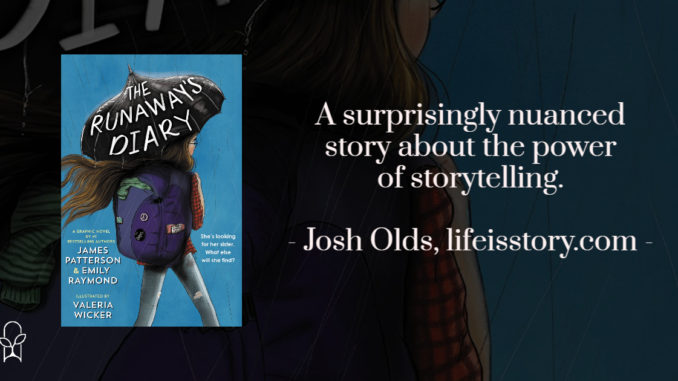
Also by this author: 1st to Die, 2nd Chance, 3rd Degree, The Horsewoman, 4th of July, The 5th Horseman, The 6th Target, 7th Heaven, The 8th Confession, The 9th Judgment, The Girl in the Castle
Published by jimmy patterson on June 7, 2022
Genres: Children's
Buy on Amazon
Goodreads

A page-turning graphic novel of sisters, secrets, and second chances.
I’m running away. Not to a place—to a person. Eleanor is happiest when she's left alone to dream up elaborate stories. Sam is polished, fun, and popular. Still, the sisters have always been there for each other—until everything changed. Now Sam is somewhere in Seattle, and Eleanor runs after her. Nothing is easy in the big, unforgiving city. As Eleanor faces new setbacks, she also makes new friends and tells new stories. Eleanor can rewrite her life in so many ways . . . but can she make a happy ending her reality?
Emily Raymond is a longtime James Patterson collaborator, particularly on books meant for middle or high schoolers. The Runaway’s Diary is no different, except for it being a graphic novel. Conceptually, I loved this book. Why is it that Patterson writes a deeper, more philosophical and nuanced story in a graphic novel aimed at young teen girls than, say, an Alex Cross novel? No idea. My one concern is that, if you miss the twist, you miss the whole foundation of the story and could be left with some questions. Currently looking at the advance reviews on Goodreads and about half of them criticize elements of the book that make sense if only you read and understand the very final panel of the book.
Eleanor is a fifteen-year-old girl who runs away from home to find her sister in Seattle. All she has to go on is a couple of postcards that are months old, a phone number that rings but is never answered, and just enough money to take the bus to Seattle. Very quickly after stepping off the bus, Eleanor learns that finding her sister isn’t going to be the grand adventure she thought it would be.
Lost and alone, she takes refuge with a grumpy woman who gives her a place to stay in exchange for cleaning the house. She walks the streets of Seattle looking for a job and trying to make money while searching for her sister. Patterson and Raymond portray a very sanitized view of homelessness and poverty. Other than a creepy guy whose advances are easily thwarted, Eleanor never really encounters any real danger.
She meets a group of homeless teens and befriends them as they teach her to survive on the streets. Multiple leads on her sister end up in failure, leaving Eleanor to contemplate life as a homeless teen in Seattle. But then, right at the end, there’s a big break and—spoilers!—her sister is found, happy and healthy, and Eleanor goes back to live with her parents.
This easy ending has left some people with a lot of questions. Eleanor has a phone. Do her parents never call her? Is nobody looking for her? Her sister has a phone. Could she not have called Eleanor, even if she had a new number (which is why the old number never worked)? Isn’t the portrayal of homelessness rather simplistic? How does Eleanor’s busking by telling stories make any sense? There’s a very real concern that The Runaway’s Diary might glamorize running away as it wraps everything up quite neatly in the end with no real harm done.
But read the title and read the last panel. The Runaway’s Diary. And the last page portrays Eleanor going home, using her real name for the first time “My name is Jane Lucia Mitchell. I live on a farm in Payette County, Idaho. I am an artist and a storyteller. And I am going home. Or maybe I never left.” Miss what that means and you miss the entire premise of the book. Why do some of the story’s decisions seem like plot holes written by a child? Because Eleanor—Jane—is the one writing the story. The story is told as if a fifteen-year-old is the one writing it. So of course the portrayal of homelessness is sanitized. Of course there’s a Cinderella ending that doesn’t make a lot of sense. The Runaway’s Diary is about a young girl processing her trauma through story.
Or is it only a story? Is Jane fantasizing about finding her runaway sister? Did she actually run away and she’s telling this story as a happy ending, making it up like she makes up stories while busking on the streets? What is truth? What is fiction? Why is the story being told? Patterson and Raymond leave all those questions unanswered. If you’re paying attention, it’s a clever turn that the duo hint at throughout the book. All the signs are there, if you’re paying attention.
Imaginative, thought-provoking, and fun—and filled with excellent artwork by Valeria Wicker—The Runaway’s Diary is a surprisingly nuanced story about the power of storytelling.
